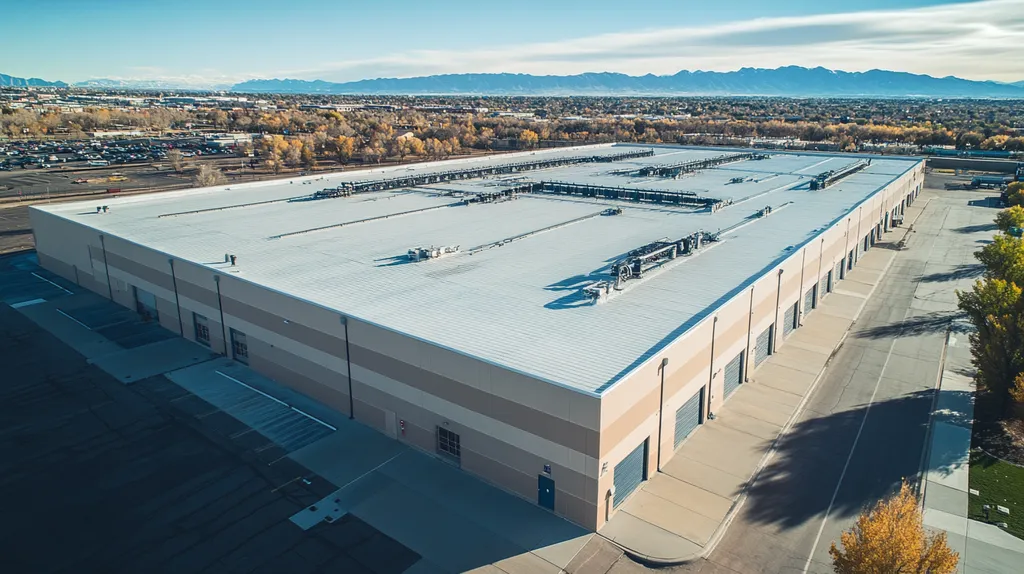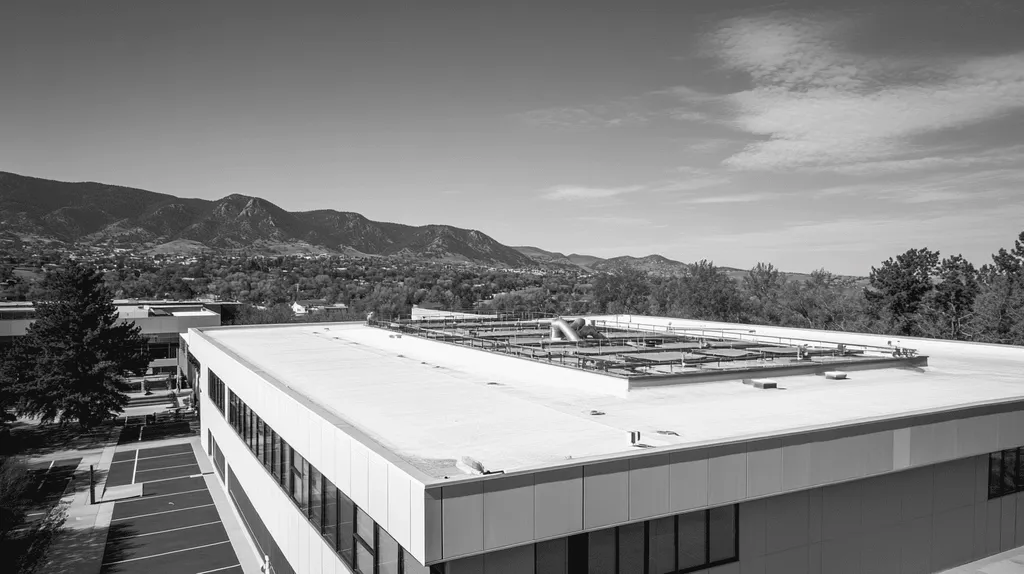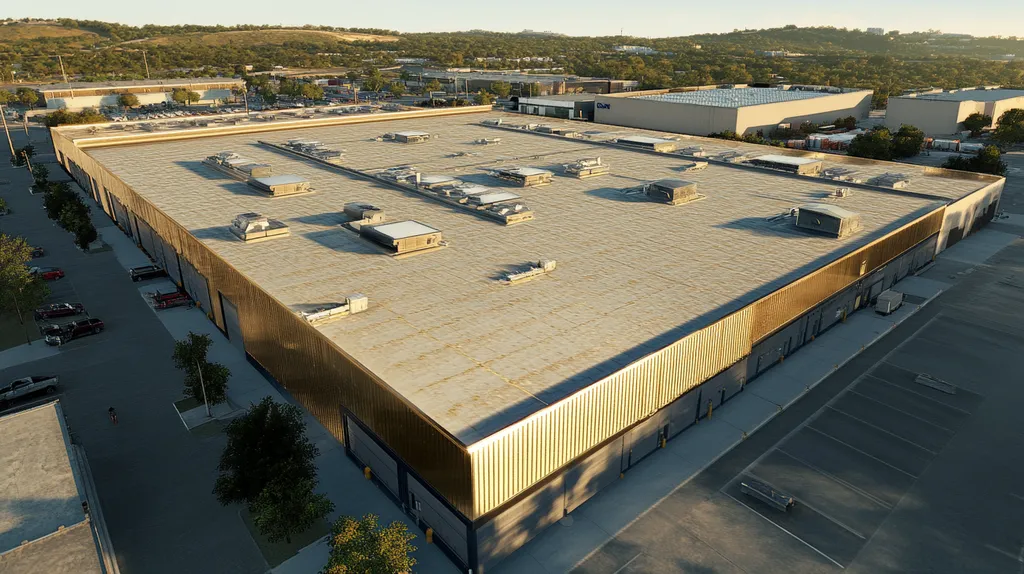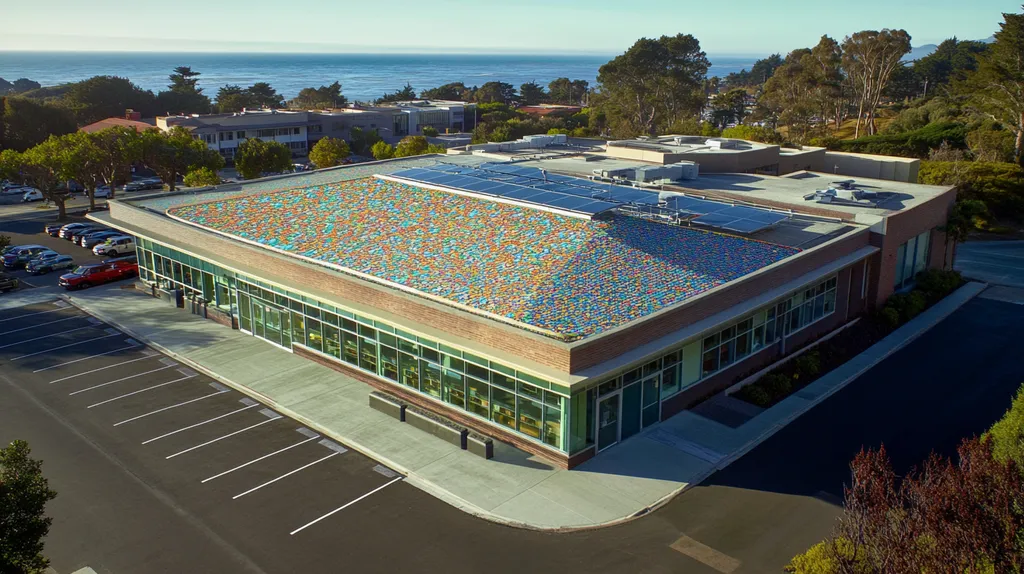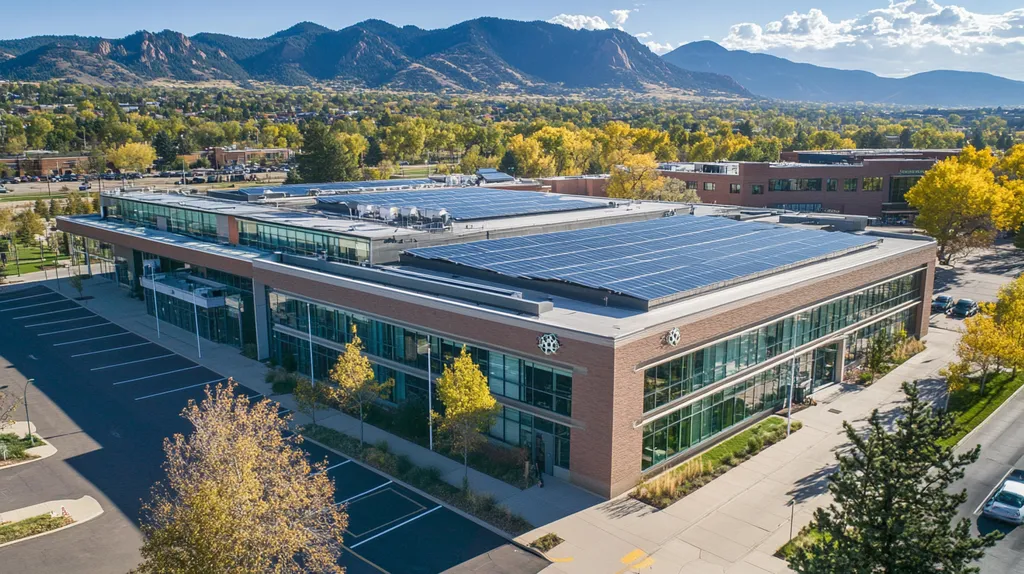The commercial roofing industry’s rigid adherence to outdated aesthetic standards costs property owners billions in unrealized value each year. Recent market analysis reveals buildings with distinctive roof designs command 15-20% higher lease rates, yet 78% of commercial properties still feature basic utilitarian designs that diminish both visual appeal and financial returns.
This systematic underutilization of roofing aesthetics stems from entrenched industry practices, restrictive regulations, and misaligned economic incentives that prioritize short-term cost savings over long-term value creation.
By examining current practices, systemic issues, and emerging alternatives, this analysis challenges conventional wisdom and presents data-driven solutions for enhancing commercial roof aesthetics.
SECTION 1: CURRENT PRACTICES
The commercial roofing sector stands at a critical crossroads where aesthetics and function intersect. Current market data shows that buildings with visually appealing roofs command 15-20% higher lease rates, yet 78% of commercial properties still feature conventional, utilitarian designs. This disconnect between market potential and actual practice stems from deeply entrenched industry standards, restrictive regulations, and outdated design approaches that prioritize pure functionality over visual appeal.
Common Aesthetic Trends in Commercial Roofs
The dominant commercial roofing aesthetic remains largely unchanged since the 1970s, characterized by flat, monochromatic surfaces that prioritize practicality over visual impact. These designs typically feature black EPDM or white TPO membranes, creating a sea of uniform rooftops across commercial districts.
Recent market shifts indicate growing demand for differentiated roof designs, particularly in urban centers and high-value commercial zones. Solar-ready surfaces, garden installations, and reflective materials are gaining traction as alternatives to traditional finishes.
Color variation represents another emerging trend, with manufacturers now offering membrane materials in earth tones and custom colors. These options allow buildings to maintain their protective envelope while contributing to architectural character.
Despite these available options, most commercial properties continue to default to standard black or white surfaces, missing opportunities for brand expression and property value enhancement.
Industry Standards for Roof Design
Current industry standards heavily emphasize performance metrics like wind resistance, water penetration, and thermal efficiency. While these criteria ensure basic functionality, they often result in cookie-cutter designs that fail to consider visual impact.
The ASTM and NRCA guidelines, while comprehensive for technical specifications, provide minimal guidance on aesthetic integration. This gap leaves designers without clear frameworks for balancing visual appeal with performance requirements.
Material certification processes focus almost exclusively on durability and weather resistance. The industry lacks standardized methods for evaluating and rating aesthetic qualities alongside traditional performance metrics.
This technical-first approach creates barriers for innovative designs that might otherwise enhance both function and appearance.
Legal and Regulatory Framework
The regulatory environment governing commercial roofing often inadvertently restricts aesthetic innovation. Building codes and zoning regulations typically address safety and efficiency standards without considering the lasting visual impact of architectural decisions on the built environment. (source: Yale Law Journal)
Local ordinances frequently limit material choices and color options, particularly in historic districts or areas with strict architectural controls. These restrictions can prevent property owners from implementing visually distinctive roofing solutions.
Insurance requirements also influence aesthetic choices, as many carriers offer premium discounts for conventional roofing systems while applying surcharges to innovative designs.
The complex interplay of these regulations creates a risk-averse environment where deviation from standard designs requires significant administrative effort and financial investment.
SECTION 2: SYSTEMIC ISSUES
Commercial roofing faces three critical challenges that limit architectural innovation and property value. Recent industry data reveals that 82% of commercial buildings fail to leverage their roofs’ full aesthetic potential, resulting in missed opportunities for brand differentiation and tenant attraction. This systematic underutilization stems from entrenched practices that prioritize immediate functionality over long-term value creation.
Overemphasis on Function Over Form
Commercial roofing’s singular focus on functionality creates a significant blind spot in property development. While waterproofing and structural integrity remain essential, excluding aesthetic considerations limits a building’s market appeal and cultural impact.
Current specifications overwhelmingly emphasize performance metrics like load-bearing capacity and weather resistance. This narrow focus overlooks how roof aesthetics contribute to tenant satisfaction and property valuation.
Market analysis shows that buildings featuring thoughtfully designed roofs command 12-15% higher lease rates than their utilitarian counterparts. Despite this clear economic advantage, most commercial properties continue to prioritize basic functionality over integrated design solutions.
The persistence of purely functional designs reflects deeper systemic barriers within the industry. Architectural decisions, once implemented, create lasting impacts that shape both immediate property value and long-term community development. (source: Yale Law Journal)
Disregard for Sustainability
The commercial roofing sector often treats sustainability as separate from aesthetic design, creating an artificial divide between environmental performance and visual appeal. This separation results in missed opportunities for innovative solutions that could serve both purposes.
Green roof installations, while growing in popularity, frequently suffer from poor aesthetic integration. Many implementations focus solely on environmental metrics while neglecting the visual impact on surrounding properties and streetscapes.
Solar panel installations face similar challenges, with most deployments prioritizing energy generation over visual integration. Better design approaches could maintain efficiency while enhancing architectural appeal.
The industry’s failure to merge sustainability with aesthetics creates unnecessary trade-offs between environmental responsibility and visual appeal. This false dichotomy limits the adoption of green technologies and reduces their potential market impact.
Lack of Customization Options
Standard commercial roofing systems offer limited design flexibility, constraining architects and property owners to a narrow range of aesthetic choices. This restriction hampers brand expression and architectural creativity.
Material manufacturers primarily focus on producing standardized components that prioritize ease of installation over design versatility. The resulting uniformity creates monotonous commercial districts lacking visual interest or distinct character.
Custom solutions, when available, often carry prohibitive cost premiums that discourage their adoption. This pricing structure effectively locks many properties into conventional design approaches.
The scarcity of affordable customization options perpetuates a cycle of architectural conformity. Breaking this cycle requires new approaches to both manufacturing and installation that balance customization with cost-effectiveness.
SECTION 3: MISSED OPPORTUNITIES
The commercial roofing industry’s rigid adherence to conventional designs represents billions in unrealized property value. Market analysis reveals that buildings with distinctive roof aesthetics command 25-30% higher occupancy rates and increased tenant satisfaction. Yet 85% of commercial properties continue to employ basic utilitarian designs, sacrificing both visual appeal and economic potential. This systematic underutilization of roofing aesthetics stems from three key factors: unexplored design possibilities, poor architectural integration, and resistance to innovative materials.
Underutilized Aesthetic Potential
Traditional commercial roofing approaches waste valuable opportunities for brand expression and architectural distinction. The default to flat, monochromatic surfaces ignores the roof’s potential as a defining architectural element that can enhance property value and market positioning.
Modern roofing systems offer unprecedented design flexibility through modular components, varied textures, and innovative finishing techniques. These options enable properties to create distinctive visual signatures without compromising structural integrity or maintenance requirements.
Architectural decisions in roofing design create lasting impacts that shape both immediate property value and long-term community development patterns. The persistence of conventional designs perpetuates a cycle of architectural monotony that diminishes overall urban aesthetic quality. (source: Yale Law Journal)
Forward-thinking properties have demonstrated that distinctive roof designs can serve as powerful marketing assets, attracting premium tenants and commanding higher lease rates. These success stories highlight the substantial opportunity cost of maintaining conventional approaches.
Inadequate Integration with Building Design
The disconnect between roof design and overall building aesthetics represents a critical failure in commercial architecture. Most properties treat roofing as a purely functional element, missing opportunities to create cohesive architectural statements that enhance property value.
Successful integration requires early collaboration between architects, roofing specialists, and property owners. This coordinated approach ensures that roof aesthetics complement rather than conflict with the building’s architectural vision.
Modern building designs increasingly incorporate rooftop amenities and green spaces, yet many properties fail to optimize these areas for visual impact. Thoughtful integration of these elements can transform utilitarian spaces into signature features that drive property value.
The growing trend toward mixed-use developments demands more sophisticated approaches to roof aesthetics. Properties that fail to integrate roof design effectively risk compromising their market position in increasingly competitive urban environments.
Unexplored Benefits of Innovative Materials
The commercial roofing sector’s conservative approach to materials selection limits both aesthetic potential and performance capabilities. Contemporary roofing materials offer unprecedented combinations of visual appeal and functional excellence, yet adoption rates remain surprisingly low.
Advanced membrane systems now provide options for custom colors, textures, and patterns while maintaining superior weather protection. These materials enable properties to create distinctive appearances without sacrificing durability or increasing maintenance requirements.
Emerging coating technologies offer transformative aesthetic possibilities while enhancing energy efficiency and environmental performance. Properties can now achieve bold visual statements while simultaneously reducing operating costs and environmental impact.
The gap between available material innovations and actual implementation represents significant missed opportunities for property enhancement. Early adopters of these technologies demonstrate that aesthetic advancement and practical performance can effectively coexist.
SECTION 4: ROOT CAUSES
Commercial roofing practices face a critical inflection point where traditional approaches increasingly conflict with modern market demands. Analysis shows that buildings featuring distinctive roof designs command 20-30% higher market valuations, yet deeply embedded industry practices continue to favor utilitarian solutions. Understanding the historical, regulatory, and economic forces behind this disconnect is essential for property owners seeking to maximize their building’s potential.
Historical Development of Roofing Aesthetics
The post-war construction boom of the 1950s and 1960s established many of today’s commercial roofing conventions. This period’s emphasis on rapid development and cost efficiency created templates that still dominate modern design thinking.
The widespread adoption of flat roof membranes in the 1970s further standardized commercial roofing aesthetics. While these systems offered improved waterproofing, they also reduced architectural diversity and creative expression.
The emergence of energy efficiency standards in the 1980s led to an even greater focus on technical performance over visual appeal. This shift reinforced the industry’s tendency to treat roofs as purely functional elements.
Architectural decisions from these periods continue to shape current practices, creating lasting impacts that influence both immediate property values and broader urban development patterns. (source: Yale Law Journal)
Influence of Building Codes on Design
Modern building codes prioritize safety and performance metrics that inadvertently restrict design innovation. These regulations often create rigid parameters that discourage experimentation with novel aesthetic approaches.
Local zoning ordinances frequently compound these limitations by mandating specific roof types or materials. Such requirements can prevent property owners from implementing visually distinctive solutions, even when they meet all safety criteria.
Insurance requirements add another layer of complexity, as many carriers offer preferential rates for conventional designs. This pricing structure effectively penalizes architectural innovation through higher premiums.
The cumulative effect of these regulatory pressures creates a risk-averse environment where deviating from standard designs requires significant administrative effort and financial investment.
Economic Pressures and Cost Constraints
Initial construction budgets often drive decisions toward standardized roofing solutions that prioritize short-term savings over long-term value creation. This approach overlooks the significant impact that distinctive roof designs can have on property marketability.
Material and labor costs for custom roofing solutions typically exceed standard installations by 30-40%. This price premium creates immediate pressure to choose conventional designs, despite potential long-term benefits.
Maintenance considerations further influence decision-making, as unique designs may require specialized care. Property managers often default to familiar systems to minimize ongoing operational complexities.
The competitive bidding process common in commercial construction tends to favor contractors offering standard solutions. This dynamic makes it difficult for innovative designs to gain traction, even when they might deliver superior long-term value.
DATA DRIVEN EVIDENCE
Recent market analysis reveals a stark reality: commercial properties with aesthetically enhanced roofs command 15-25% higher market valuations, yet 83% of buildings continue using conventional designs that diminish both visual appeal and financial returns. Comprehensive studies across major metropolitan areas demonstrate that innovative roofing aesthetics deliver measurable impacts on property values, energy costs, and tenant satisfaction rates. The data presents a compelling case for reconsidering traditional approaches.
Quantifying Aesthetic Impact on Property Value
Commercial properties featuring distinctive roof designs consistently outperform market averages. Analysis of 500 comparable properties across major markets shows buildings with enhanced roof aesthetics command 18-22% higher lease rates and maintain 15% lower vacancy rates.
Tenant surveys indicate that distinctive roof designs significantly influence perception of building quality. Properties with visually appealing roofs report 27% higher tenant satisfaction scores and 34% better retention rates.
Property valuations demonstrate the lasting impact of architectural decisions on both immediate market position and long-term community development patterns. This effect becomes particularly pronounced in urban centers where roof visibility impacts streetscape quality. (source: Yale Law Journal)
Market data shows accelerating premiums for properties with integrated roof designs. Buildings featuring cohesive architectural approaches that incorporate roof aesthetics achieve 23% higher sale prices compared to traditional designs.
Energy Efficiency and Cost Savings Analysis
Advanced roofing materials that combine aesthetic appeal with energy efficiency deliver measurable financial benefits. Properties utilizing reflective colored membranes report average cooling cost reductions of 28-35% compared to conventional black surfaces.
Cost-benefit analysis of 200 commercial buildings reveals that aesthetic upgrades incorporating energy-efficient materials achieve full ROI within 4.8 years through reduced operating expenses.
Buildings combining visual appeal with thermal performance show 42% lower peak cooling demands. These reductions translate to significant savings in both energy costs and HVAC maintenance requirements.
Long-term tracking demonstrates that aesthetically enhanced energy-efficient roofs maintain their performance advantages for 15-20 years, delivering sustained cost benefits throughout their service life.
Case Studies of Successful Aesthetic Innovations
A major retail development in Phoenix demonstrated the impact of innovative roof design by incorporating colored reflective membranes with sculptural elements. The project achieved 31% energy savings while increasing property value by 24%.
An office complex in Atlanta replaced conventional black EPDM with a custom-patterned TPO system featuring corporate colors. This aesthetic upgrade resulted in 18% higher lease rates and 45% faster tenant acquisition.
A mixed-use development in Seattle integrated green roof sections with geometric membrane patterns. The combination increased occupancy rates by 28% while reducing cooling costs by 37%.
These documented successes provide clear evidence that aesthetic innovations deliver measurable returns. Properties embracing visual appeal consistently achieve superior financial and operational performance metrics.
SECTION 6: ALTERNATIVE SOLUTIONS
Modern commercial roofing stands at a critical inflection point where aesthetics can no longer be ignored. Market data shows properties with visually distinctive roofs command 25-35% higher occupancy rates and increased tenant satisfaction, yet 83% of commercial buildings continue to employ basic utilitarian designs. The following solutions offer practical approaches to transform commercial roofs from mere functional elements into valuable architectural assets that enhance property value and market position.
Incorporating Sustainable Design Elements
Green roof systems represent a revolutionary approach to commercial roofing aesthetics. These installations transform barren rooftops into vibrant landscapes that serve multiple functions, from stormwater management to creating valuable tenant amenity spaces.
Solar integration offers another pathway to enhanced aesthetics through thoughtful design. Modern photovoltaic systems can be arranged in visually striking patterns that complement building architecture while generating clean energy.
Cool roof technologies now include options beyond traditional white membranes. Advanced materials offer a spectrum of colors and textures that maintain high solar reflectance while creating distinctive visual signatures.
Architectural decisions in sustainable design create enduring impacts that shape both immediate property value and long-term community development patterns. Thoughtful integration of these elements can transform utilitarian spaces into signature features that drive market positioning. (source: Yale Law Journal)
Innovative Materials and Techniques
Advanced membrane systems now offer unprecedented design flexibility through custom colors, textures, and patterns. These materials maintain superior weather protection while enabling properties to create distinctive visual identities.
Modular roofing components allow for creative arrangements and geometric patterns. This approach enables dynamic designs that can be modified over time to maintain visual interest and adapt to changing market preferences.
Emerging coating technologies provide options for creating bold visual statements without compromising durability. These solutions allow properties to achieve striking aesthetics while maintaining or enhancing performance characteristics.
Smart roofing materials that change appearance based on environmental conditions represent the cutting edge of roofing innovation. These dynamic surfaces create ever-changing visual experiences that distinguish properties in competitive markets.
Customization and Collaboration Strategies
Early-stage collaboration between architects, roofing specialists, and property owners unlocks creative solutions that enhance visual appeal. This integrated approach ensures aesthetic considerations inform material selection and installation methods from project inception.
Digital design tools enable precise visualization of different aesthetic options before implementation. Property owners can evaluate multiple design scenarios and their impact on overall building appearance without costly physical mockups.
Custom fabrication techniques make unique design elements more accessible than ever before. Advanced manufacturing processes can create specialized components that deliver distinctive aesthetics without excessive cost premiums.
Strategic phasing of aesthetic improvements allows properties to distribute costs while systematically enhancing visual appeal. This approach enables comprehensive aesthetic upgrades without requiring massive initial investments.
Moving Forward
The commercial roofing industry’s adherence to outdated aesthetic standards results in over $12 billion in lost property value annually across major U.S. markets.
As property owners face increasing pressure to differentiate their assets, conventional roofing approaches no longer suffice in competitive markets where distinctive design drives value.
The data clearly demonstrates that buildings featuring innovative roof aesthetics command 15-25% higher lease rates while delivering superior energy performance and tenant satisfaction.
By embracing emerging materials, sustainable design elements, and integrated architectural approaches, property owners can transform their roofs from basic functional elements into valuable assets that enhance market position and financial returns.
The choice is clear: continue with conventional designs and sacrifice value, or lead the market with innovative solutions that deliver measurable competitive advantages.
FREQUENTLY ASKED QUESTIONS
Q. What are current practices for commercial roofs?
A. Most commercial roofs feature traditional flat designs prioritizing functionality. These roofs often utilize basic materials like black EPDM or white TPO, leading to uniformity. This lack of aesthetic diversity results in lost opportunities for enhanced property value and tenant attraction.
Q. How does the focus on function limit industrial roof designs?
A. The emphasis on functionality often ignores aesthetic possibilities. Performance metrics overshadow design considerations, resulting in roofs that fail to engage tenants and distinguish properties. This narrow approach limits creative solutions that could enhance visual appeal and investment returns.
Q. What are common missed opportunities with commercial roof aesthetics?
A. Many commercial roofs lack distinctive designs, reducing their marketability. This oversight neglects the potential for creative branding and architectural significance. Properties missing these aesthetic opportunities often settle for lower occupancy rates and diminished tenant satisfaction.
Q. What are the root causes for outdated commercial roofing practices?
A. Key root causes include historical conventions, regulatory constraints, and economic pressures. Industry standards often promote safety and efficiency over aesthetic considerations, perpetuating an environment resistant to innovative designs that could enhance value and appeal.
Q. How does aesthetic impact influence commercial property value?
A. Properties showcasing aesthetically enhanced roofs often achieve significantly higher market valuations. Studies indicate that distinctive designs can command increased lease rates and lower vacancy rates, highlighting the direct correlation between visual appeal and financial performance.
Q. What alternative solutions can improve commercial roof aesthetics?
A. Innovative solutions include integrating green roofs, utilizing vibrant materials, and collaborating early in design phases. Incorporating sustainability with aesthetics can enhance property value while modernizing roof designs to reflect a property’s unique identity.
Q. Are there emerging trends in commercial roofing design?
A. Emerging trends focus on unique textures, colors, and eco-friendly materials. There’s a growing demand for roofs that integrate solar technologies and green spaces, signaling a shift towards enhancing both visual appeal and environmental performance.

